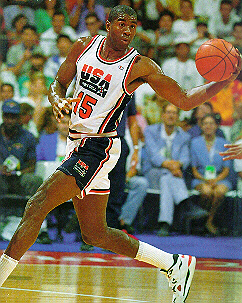
The familiar eye chart that is pictured above is called the Snellen chart. It is based on the work of Dutch ophthalmologist Dr. Hermann Snellen, who in 1862 designed this system for describing human vision. By testing the eyes of a multitude of people, eye doctors have decided what a ‘normal’ human being should be able to see when standing 20 feet away from an eye chart. If you have 20/20 vision in one of your eyes, it means that when you stand 20 feet away from the chart you can see what the ‘normal’ human being can see. In the metric system, the standard is 6 meters (approximately equal to 20 feet) and its called 6/6 vision. So if you have 20/20 vision your vision is ‘normal’--a majority of people in the population can see what you see at 20 feet. If you have 20/40 vision, it means that when you stand 20 feet away from the chart you can see what a normal human can see when standing 40 feet from the chart. That is, if there is a normal person standing 40 feet away fom the chart and you are standing only 20 feet away from it, you and the normal person can see the same detail. You can also have vision that is better than normal, a person with 20/10 vision can see at 20 feet what a normal person can see when standing 10 feet away from the chart.
20/20 - Normal vision. Fighter pilot minimum. Required to read the stock quotes in the newspaper, or numbers in the telephone book.
20/40 - Able to pass Driver's License Test in all 50 States. Most printed material is at this level.
20/80 - Able to read alarm clock at 10 feet. News Headlines are this size.
20/200 - Legal blindness. Able to see STOP sign letters
Some people can see well at a distance, but are unable to bring nearer objects into focus. This condition can be caused by hyperopia (farsightedness) or presbyopia (loss of focusing ability). Others can see items that are close, but cannot see those far away. This condition may be caused by myopia (nearsightedness). Today’s technology offers a myriad of corrective lenses and procedures to allow everyone the opportunity to see the world as a ‘normal’ person. But there are other types of vision which go beyond the physical limitations of sight.

Peripheral vision is a type of vision that is very useful in sports and in the street sense of being ‘watchful’ of what’s going on around you. Magic Johnson's ability to throw ’no -look’ pin point passes to the streaking James Worthy on a fast break was a display of uncanny peripheral vision. This is also a valuable skill to be used while walking on a crowded street, you never know when a jacker, mugger or pickpocket is walking/standing right next to you, waiting to catch you unaware and ‘slipping’.
A lot of successful golfers benefit from the use of tunnel vision. This is the ability to block out all the actions, sounds and commotion going on in the background and focus completely on the task at hand. When you see Tiger Woods crouching down to line up a putt, and he uses both of his hands to form a set of ‘blinders’ around his eyes, he is using visualization and ‘tunnel vision’ to focus in on the line and speed required to sink the putt. Tunnel vision can be extremely beneficial toward goal seeking, but it can also be hazardous for those who get ‘caught up’ with small details and fail to remember the big picture. A common expression for this occurrence is those who ‘can’t see the forest because of all the trees’.
We all have our own goals and dreams that we have our sights set upon. Some have clear visions of retirement days full of leisure, travel and enjoyment. Others are just trying to make it, one day at a time. And then there are some who’s vision is even more shortsighted, Guru from Gangstarr penned this verse about ‘stick-up kids‘, “..they all live for the minute and they caught up in it.” We’re living in a society with a diverse mix of mentalities. A lot of people have lost all hope for a better day and their only vision is of immediate gratification. They pay no heed to their own personal safety as well as others, they don’t care if they end up going to jail and some really don’t even care if they live to see the next day. I strive to make direct eye contact with all of those around me. The ‘look’ in a person’s eyes are good indicators for their state of mind. A lot of people walking the streets are not ‘at’ themselves and they’re under the influence of some foreign substance like drugs, alcohol and/or hate. The common creed on the Southside is to ‘keep your eye on them haters’, because you never know when they will strike at the opportunity to inflict harm. The best advice I can give anyone is to have their vision checked regularly by a professional and stay watchful of the things that are going on around you, haters prefer to attack from the blindside.
Copyright © 2003 www.servinemup.com All Rights Reserved